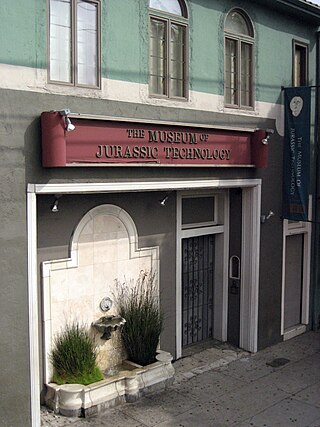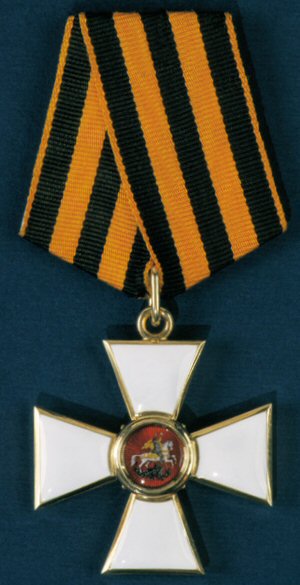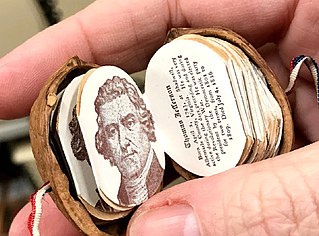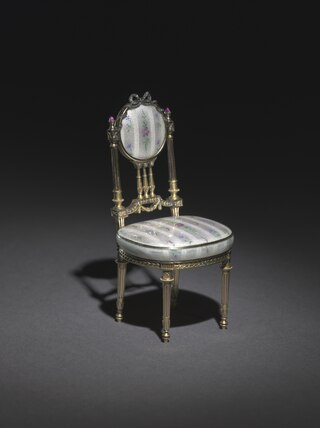
The Museum of Jurassic Technology at 9341 Venice Boulevard in the Palms district of Los Angeles, California, was founded by David Hildebrand Wilson and Diana Drake Wilson in 1988. It calls itself "an educational institution dedicated to the advancement of knowledge and the public appreciation of the Lower Jurassic", the relevance of the term "Lower Jurassic" to the museum's collections being left uncertain and unexplained.

The Order of Saint George is the highest military decoration of the Russian Federation. It was originally established on 26 November 1769 Julian as the highest military decoration of the Russian Empire for commissioned officers and generals by Empress Catherine the Great. After the October Revolution in 1917, it was awarded by the White movement under Alexander Kolchak until their collapse in 1921. The order was revived in the Russian Federation on 20 March 1992 by Decree №1463 of the President of Russia. The current award criteria were amended on 7 September 2010 by Presidential Decree 1099.
Nicolai Ghiaurov was a Bulgarian opera singer and one of the most famous basses of the postwar period. He was admired for his powerful, sumptuous voice, and was particularly associated with roles of Mussorgsky and Verdi. Ghiaurov married the Bulgarian pianist Zlatina Mishakova in 1956 and Italian soprano Mirella Freni in 1978, and the two singers frequently performed together. They lived in Modena until Ghiaurov's death in 2004 of a heart attack.

Peredvizhniki, often called The Wanderers or The Itinerants in English, were a group of Russian realist artists who formed an artists' cooperative in protest of academic restrictions; it evolved into the Society for Travelling Art Exhibitions in 1870.

A miniature book is a very small book. Standards for what may be termed a miniature rather than just a small book have changed through time. Today, most collectors consider a book to be miniature only if it is 3 inches or smaller in height, width, and thickness, particularly in the United States. Many collectors consider nineteenth-century and earlier books of 4 inches to fit in the category of miniatures. Book from 3–4 inches in all dimensions are termed macrominiature books. Books less than 1 inch in all dimensions are called microminiature books. Books less than 1/4 inch in all dimensions are known as ultra-microminiature books.

Willard Wigan, is a British sculptor from Ashmore Park Estate, Wednesfield, England, the son of Jamaican immigrants, who makes micro miniature sculptures. His sculptures are typically placed in the eye of a needle or on the head of a pin. A single sculpture can be as small as 0.005 mm (0.0002 in).

The Soviet Union (USSR) competed at the 1964 Summer Olympics in Tokyo, Japan. 317 competitors, 254 men and 63 women, took part in 154 events in 19 sports.

Miniature art includes paintings, engravings and sculptures that are very small; it has a long history that dates back to prehistory. The portrait miniature is the most common form in recent centuries, and from ancient times, engraved gems, often used as impression seals, and cylinder seals in various materials were very important. For example most surviving examples of figurative art from the Indus Valley civilization and in Minoan art are very small seals. Gothic boxwood miniatures are very small carvings in wood, used for rosary beads and the like.
Events from the year 2005 in Russia.
David Hildebrand Wilson is the co-founder, along with his wife, Diana Wilson, of the enigmatic Museum of Jurassic Technology in Los Angeles, California.

Hagop Sandaldjian (1931–1990) was an Egyptian-born Armenian American musician and microminiature sculptor, best known for his tiny art pieces, currently displayed at the Museum of Jurassic Technology in Los Angeles, California. Sandaldjian's creations included a carving of Mount Ararat on a grain of rice; a crucifix in which a minute golden figure of Jesus hangs upon a cross made from a bisected strand of Sandaldjian's own hair; and recreations of Disney figures or historical figures presented in the eye or on the tip of a needle.
Nikolai Aldunin is a Russian artist noted for his microscopic art described as "masterpieces" and "pioneering work", "famous in Russia and around the world". His work includes a T-34 tank a fraction of the size of an apple seed and composed of more than 200 pieces, made of pure gold and described as "perfect copy of a real vehicle"; a gold saddle and horseshoes for a flea; and a camel train in the eye of a needle.

Anatoly Ivanovich Konenko is a microminiature painter and sculptor from the Russian city of Omsk. In 1996 he was entered into the Guinness Book of World Records for creating the world's smallest book.

The Leningrad School of Painting is a phenomenon that refers to a large group of painters who developed in Leningrad around the reformed Academy of Arts in 1930–1950 and was united by the Leningrad Union of Soviet Artists (1932–1991).

The Order of Sukhbaatar is a state decoration of Mongolia, originally instituted on 16 May 1941. It was awarded to Mongolians and foreigners "for special services to defenses, economic and cultural construction of the Mongolian People's Republic, and also for acts of heroism in the struggle against external and internal enemies". It was named after the Mongolian national hero, Damdin Sükhbaatar. It is still conferred today and has been the highest state order since 1992, awarded by the decree of the President of Mongolia.

The Regional Art Exhibition "Our Contemporary" became one of the most important and largest Soviet Art exhibition of the 1970s. The Exhibition took place in the State Russian Museum and in the exhibition halls of the Leningrad Union of Soviet Artists.

The Second National Art Exhibition "Soviet Russia" was one of the largest Soviet art exhibitions of the 1960s. The exhibition took place in Manezh Exhibition Hall.
Note: Except where otherwise stated, the date is that on which the individual was executed by shooting.
















